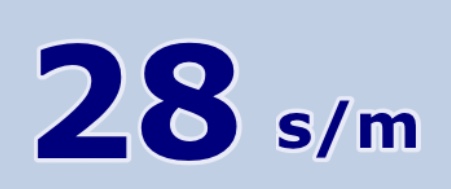Rowing Stroke Rate Explained

On your Performance Monitor, the number in the upper right corner on every workout display is “Strokes Per Minute” ("s/m" or "spm"). Athletes see this number on every stroke, so it must be important. But why? And what number should it be?
Stroke rate is the number of strokes you take per minute. As explained in Debunking the Myths: Damper Setting, Stroke Rate and Intensity, the intensity of your workout isn’t determined by how high your cadence is; it’s based on how hard you’re pulling.
If you’re able to maintain the same technique and intensity on every stroke, a higher stroke rate means a faster performance—because you’re fitting in more of those same powerful strokes in each minute. The problem is that for most of us, a higher stroke rate is challenging to achieve well! For one thing, it can be very difficult to coordinate the same technique skills at a faster pace. For example, with more momentum, it is difficult to maintain a strong body position without lunging at the catch.
In addition, a higher stroke rate also requires more energy to maintain. This is tiring! So, the body often compensates. If, when you increase your stroke rating, you shorten your stroke, change your technique, or are unable to maintain the same intensity, a higher stroke rate won’t result in a faster row. Maximum speed only happens when the best technique is matched to a sustainable spm.
So what is the best stroke rate for your row? It will depend a bit on your goals. If you're looking to build endurance, for example, longer rows will require a lower stroke rate than intervals. Many athletes also find that their stroke rate is a few beats higher on the Dynamic Indoor Rower than on our Model D or Model E.
Here are some general guidelines to help match your stroke rate to your workouts:
18-22 spm
At lower stroke rates, the flywheel has more time to slow down between each stroke. So, it will take more work to get it up to speed. This increases the load and feel of the stroke. Lower stroke rates are useful for practicing technique, stroke sequence, and rhythm—but may feel more like a strength workout than an aerobic workout. Long hard workouts at this stroke rate are not recommended.
24-28 spm
These stroke rates tend to be comfortable for steady state workouts. These rates are slow enough to allow for good, strong technique that can be maintained. This range is recommended for longer workouts.
30-36 spm
Higher stroke rates are easier to maintain over short distances. These stroke rates demand fast twitch muscles and speedy coordination. Higher stroke rates are best practiced with interval training and for racing distances up to 2000 meters.
38+ spm
Adept crews and athletes use high stroke rates for racing and short distances. At the World Rowing Championships, fast men’s crews finished some races at 47 spm! There is an upper limit to efficient use of the stroke. It would be difficult to achieve greater speed much above this spm given the complexities of the stroke and best use of the large muscle groups (such as the legs, which should be used at full compression).
You will find an optimal stroke rate for your best rowing. Some shorter athletes find that they can maintain faster stroke rates than their taller peers! The best stroke rate is one that you can maintain for the amount of work time (or distance) demanded with good technique. If you increase your stroke rate but cannot maintain it, then it is recommended that you decrease your stroke rate. If you increase your stroke rate but don’t see your pace improve, that is a sign that your technique is suffering. Decrease your stroke rate to where you gain speed by rowing correctly. The goal is to row well to row fast.
Note: Stroke rates are often discussed as even numbers, but workouts can also be done at odd stroke rates (19, 21, etc.) and will sometimes show up on the PM as halves (22 ½ spm). With stroke by stroke data, it can be a challenge to maintain the exact same rate throughout an entire workout. The goal is to average a stroke rate within two strokes of the given range.
